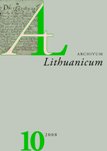Senoji lietuvių raštija internete
The old Lithuanian writings on the internet
Author(s): Ona AleknavičienėSubject(s): Theoretical Linguistics, Applied Linguistics, Historical Linguistics, Baltic Languages, ICT Information and Communications Technologies
Published by: Lietuvių Kalbos Institutas
Keywords: Old Lithuanian writings; Internet; 16th-17th century; Lithuanian language;
Summary/Abstract: This article deals with the state of digitalization of the old Lithuanian writings throughout the world. Attention is focused on the database of old Lithuanian writings in the Institute of the Lithuanian Language in Vilnius. The first writings transferred to electronic files were of the sixteenth and seventeenth century. These are the aims of the database of old Lithuanian writings in the Institute of the Lithuanian Language: (1) to preserve linguistic, cultural, and historical information of old sources in different electronic formats; (2) to make valuable printed works and manuscripts easily accessible to the research community and to contribute to the development and promotion of Lithuanian studies; (3) to promote up-to-date research of seventeenth through eighteenth century written Lithuanian and to disseminate its results in traditional and electronic formats; (4) to involve scholars in Lithuania and elsewhere in research projects related to old Lithuanian. The database of old Lithuanian writings consists of: (1) transcribed texts, (2) concordances, (3) indices, (4) facsimiles. The texts are transcribed using the Lithuanian Unicode font Palemonas (http://www.vlkk.lt/palemonas.html). They serve as the basis for generating word-form concordances: the texts are processed with the help of systems of software modules. In the concordances, word-forms are given in alphabetic order with references to the source (abbreviation, page and line number); then follows the excerpt of the text with the relevant word-form. There are three types of concordances: (1) direct, (2) reverse (a tergo), and (3) descriptive. Descriptive concordances constitute the basis for the word indices and the computerized database of old writings.
Journal: Archivum Lithuanicum
- Issue Year: 2008
- Issue No: 10
- Page Range: 297-350
- Page Count: 54
- Language: Lithuanian

